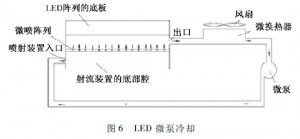4. Micro-channel cooling technology. Similar to synthetic micro-spraying, micro-channel cooling is also a new born cooling technology for super high power LED lights. In 1980s, Tuckerman and Pease introduced a kind of micro-channel cooling concept in their report. The thickness of this device is only 50um. Although this technology has been put forward theoretically, it is very difficult to be realized due to the relatively backward manufacturing level. 20 years later, Mr. Goodson and his colleagues invented electroosmotic pump: non-motion component, lower power consumption. Tests results demonstrated that when thermal flux reaches 200W, micro-channel drove by electroosmotic pump can cool LED STREET LIGHT chips nearly 20 degrees, while the power consumption is less than 1W. So far this cooling technology has not been commercialized.
5. Thermoelectric refrigeration cooling technology. Different from the previous methods, thermoelectric refrigeration can create a much colder surface within a certain area by using Peltier effect. This technique can used in large space, but the cooling effect is only 10% of micro-channel cooling technology and also much lower than other cooling technologies. Thus it cannot be used in super high power LED lights.

Chinese designers also promoted their own LED cooling concepts. Mr. Mao introduced a kind of channel cooling module that used for LED blocks in 2005. He connected LED boards with MMC (Metal Metric Composite) plates or silicon plates, then “carved” small channels on these plates though micromachining technology. Liquid can flow though these channels, carrying off heat with no influence on LED boards. To enhance the cooling effect, Mr. Mao also set several small auxiliary heat sinks on plates.
In 2006, Sheng Liu and his colleagues tried to solve cooling problems of super high power LED lights by using micro-pumps. They connect LED boards on slots-covered plates. Cooling water will be impelled though these slots under the work of micro-pumps, taking away heat. The over-heated water is then cooled down by fans within a block. These micro-pumps have very good cooling capacity, but internal interfaces generally have large thermal resistances, reducing the final cooling effect. And also the complex construction made LED manufacturers have little interest in applying this technique in their LED HIGH BAY applications.
